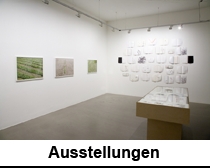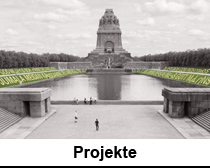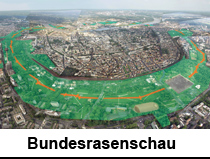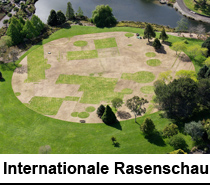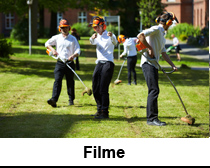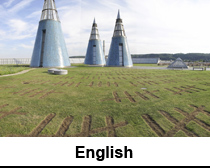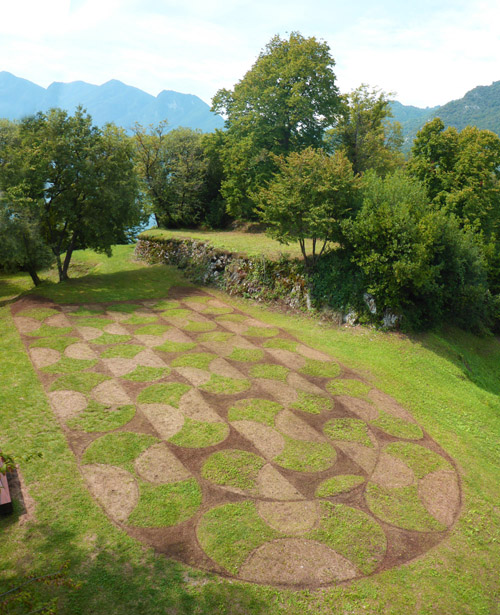
english and italian version and more photos below
Das Kunstwerk LA INSULA NOVA des Künstlers Ralf Witthaus ist eine Bodenzeichnung, die die Besucher frei bewandern können. Es ist auf dem ersten Blick ein großes Muster aus Halbkreisen, eine Formfindung die an die Bewegung von Wellen erinnert. Die äußere Form eines Schlauchbootes erkennt man aufgrund der Größe der Zeichnung erst auf den zweiten Blick – oder aus der Luft. Das Muster dieses etwa 240 qm großen Schlauchbootes wirkt wie ein 70er Jahre Dekor – und damit erinnert das in den Rasen gezeichnete Bild des deutschen Künstlers an die Freizeit-, Spaß- und Luxuskultur, die heute maßgeblich für den Comer See ist. Doch dieses lebensfrohe Muster ist etwa 1300 Jahre alt: Jeder, der die Insel kennt, weiss, dass es einer der erstaunlichen Dekoration nahekommt, die sich in der archäologischen Zone befindet. Das Kunstwerk bezieht sich damit auf die Historie des Ortes.
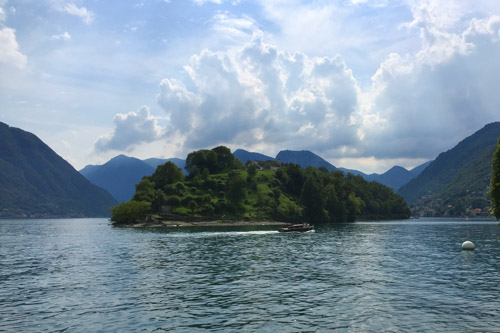
Die Isola Comacina war nicht immer ein Ort der Ruhe so wie heute. Genauer gesagt war sie einst eine für die damalige Zeit stark bebaute und befestigte Machtmetropole. Das hatte im Jahr 1169 ein jähes Ende: Die Stadt Como zerstörte bei einem Rachefeldzug die komplette Inselgesellschaft und unterband jede weitere Siedlungsgeschichte an diesem Ort für die Zukunft. Trotzdem nennen die Einheimischen noch 50 Generationen nach diesem Krieg ihre Insel „El Castèl“ – Es ist noch immer ihr „Schloss“.
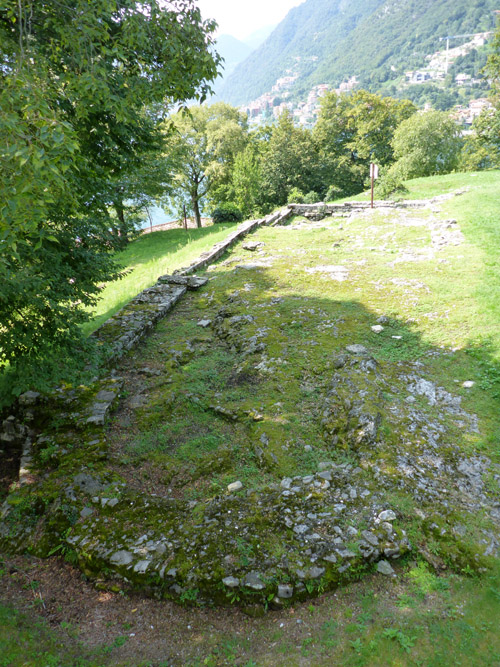
Die Zeichnung im Rasen ist in ihrer Ausmessung ähnlich gehalten wie die unweit erhaltenen Grundmauern der geschliffenen Kirchen. Um es mit einem anderen Wort zu sagen: Das Kunstwerk ist ähnlich groß wie eines dieser Kirchenschiffe.
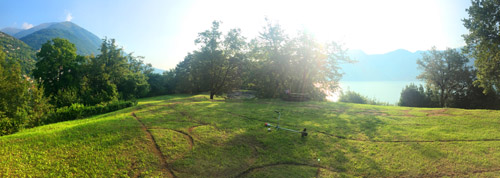
Eigentlich stehen Kirchen für Sicherheit – viel mehr als Schiffe: Das Kirchenasyl hat einen seit jeher hohen Stellenwert, und in Kriegen hat man Kirchen weitgehend verschont. Auf der Isola Comacina sind die Kirchen jedoch allesamt zerstört und überaus gründlich abgetragen worden. Die Fundamente der Gebäude und die wenigen Reste der Wandmalereien, Töpfereien und Bodenmosaike sind das einzige was sich neben den Überlieferungen und Legenden noch finden lässt.
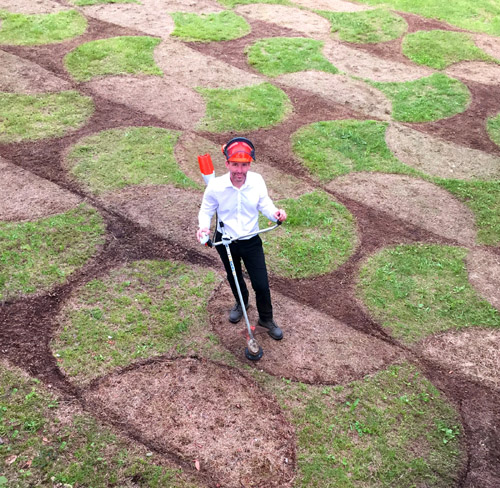
Die Überlieferung sagt auch hoffnungsvolles: Die Menschen, die das Inferno des „Castéls“ überleben konnten, flüchteten zu einem Ort, der der Legende nach LA INSULA NOVA (die neue Insel) heißt, und auf der anderen Seite des Comer Sees in der Höhe von Varenna liegt. Da es keinen Hinweis gibt, dass es je eine zweite Insel am Comer See gegeben hat, ist es zu vermuten, dass dies ein symbolischer Name ist.

Vielleicht erzählt uns diese Historie etwas über die Gegenwart. Auch wenn LA INSULA NOVA weit weg vom Mittelmeer ist, und auf eine Geschichte verweist die fast 1000 Jahre alt ist, so erinnert uns das Kunstwerk ebenfalls daran, dass Menschen auch heute – vielleicht mehr denn je – auf der Flucht sind und auf der Suche nach einem sicheren Eiland.
Besten Dank: Fondazione Isola Comacina, Museo Antiquarium, Accademia di Belle Arti di Brera und STIHL.
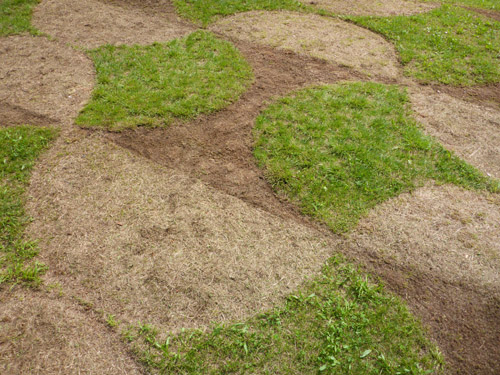
english translation:
The artwork LA INSULA NOVA by the artist Ralf Witthaus is a ground drawing that visitors can freely walk through. At first glance it is a large pattern of semicircles, a finding of form reminiscent of the movement of waves. The outer shape of an rubber boat can only be recognized at second glance – or from the air – due to the size of the drawing. The pattern of this rubber boat, about 240 square metres in size, looks like a 1970s décor – and thus the picture drawn in the lawn by the German artist is reminiscent of the leisure, fun and luxury culture that today is so important for Lake Como. But this lively pattern is about 1300 years old: everyone who knows the island, knows that it comes close to one of the amazing decorations located in the archaeological zone. The work of art thus refers to the history of the place.
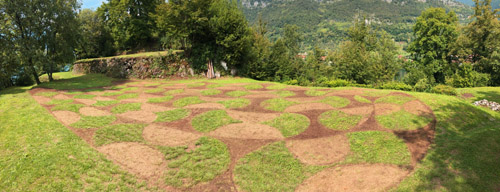
The Isola Comacina has not always been a place of calm as it is today. To be more precise, it was once a power centre, heavily built and fortified for that time. This came to an abrupt end in 1169: during a revenge campaign, the city of Como destroyed the entire island society and undermined any further settlement history in this place for the future. Nevertheless, 50 generations after this war, the locals still call their island „El Castèl“ – it is still their „castle“.
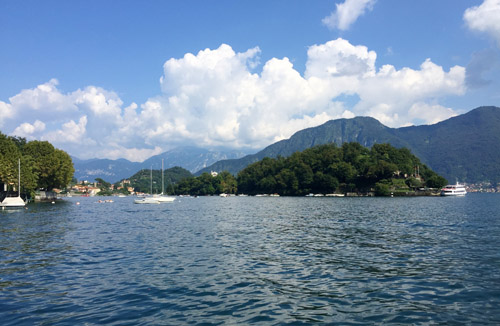
The drawing in the lawn is similar in size to the nearby ground walls of the destroyed churches. In the words of Ralf Witthaus, the work of art is as large as one of these „Kirchenschiffe“ – a German word that describes the architecture of a church as ship-like.
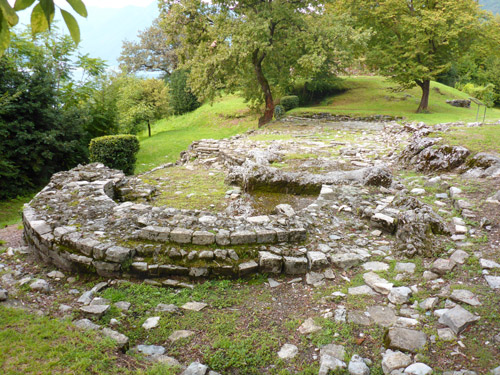
Churches actually stand for safety – much more than ships: Church asylum has always been of great value, and churches have largely been preserved in wars. On the Isola Comacina, however, the churches have all been destroyed and thoroughly removed. The basement of the buildings and the few remains of the wall paintings, pottery and floor mosaics are the only things that can still be found besides the narratives and legends.
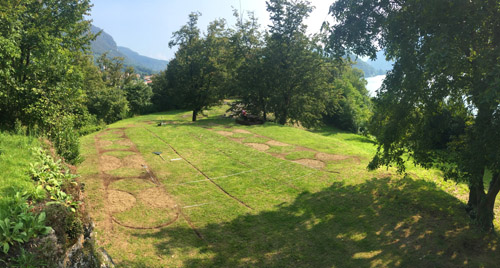
The legend also says that the people who survived the inferno of the „Castéls“ fled to a place called according to legend LA INSULA NOVA (the new island), on the other side of Lake Como, near Varenna. Since there is no indication that there has been a second island on Lake Como, it can be assumed that this is a symbolic name.

Perhaps this history tells us something about the present. Even though LA INSULA NOVA is far away from the Mediterranean Sea, and refers to a history that is almost 1000 years old, the work of art also reminds us that people today – perhaps more than ever – are on the run and in search of a safe island.
Thanks a lot:
Fondazione Isola Comacina, Museo Antiquarium, Accademia di Belle Arti di Brera and STIHL.
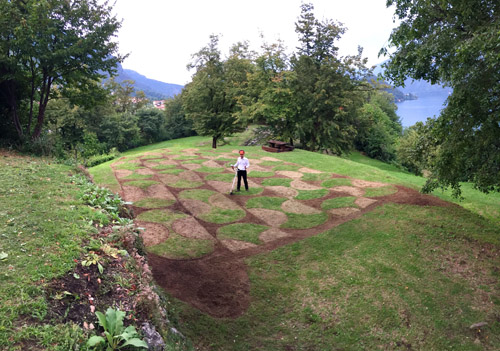
italiano
L’opera LA INSULA NOVA dell’artista Ralf Witthaus è un disegno a terra che i visitatori possono attraversare liberamente. A prima vista è un grande disegno a semicerchio, un reperto di forma che ricorda il movimento delle onde. La forma esterna di un gommone si riconosce solo al secondo sguardo – o dall’aria – a causa delle dimensioni del disegno. Il disegno di questo gommone, di circa 240 metri quadrati, sembra un arredamento degli anni ’70 – e quindi il disegno disegnato nel prato dall’artista tedesco ricorda la cultura del tempo libero, del divertimento e del lusso che oggi è così importante per il Lago di Como. Ma questo vivace disegno ha circa 1300 anni: tutti coloro che conoscono l’isola, sanno che si avvicina a una delle splendide decorazioni che si trovano nella zona archeologica. L’opera d’arte si riferisce quindi alla storia del luogo.
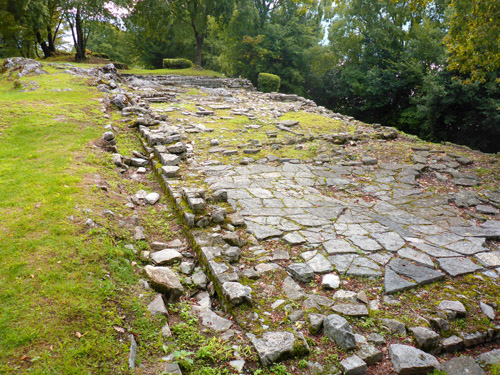
L’Isola Comacina non è sempre stata un luogo di tranquillità come lo è oggi. Più precisamente, un tempo era un centro di potere, per l’epoca pesantemente costruito e fortificato. Tutto questo si concluse bruscamente nel 1169: durante una campagna di vendetta, la città di Como distrusse l’intera società isolana e minò la storia degli insediamenti futuri in questo luogo. Tuttavia, 50 generazioni dopo questa guerra, i comaschi continuano a chiamare la loro isola „El Castèl“ – è ancora il loro „castello“.
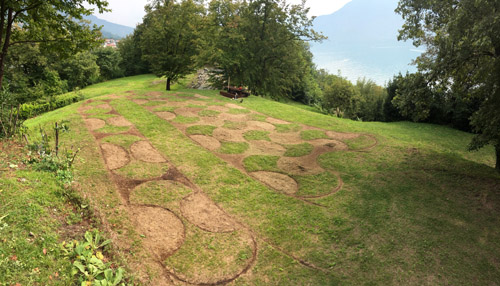
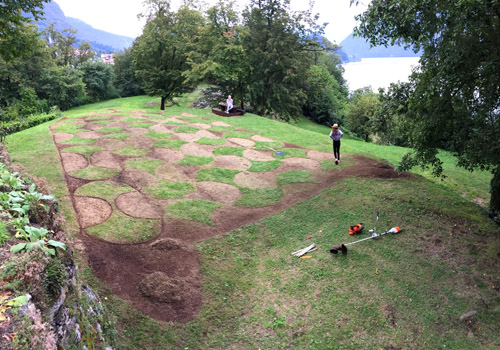
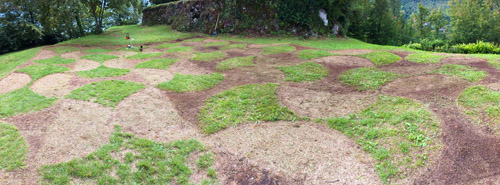
Il disegno nel prato è simile per dimensioni alle vicine mura di terra delle chiese distrutte. Secondo le parole di Ralf Witthaus, l’opera d’arte è grande quanto una di queste „Kirchenschiffe“ – una parola tedesca che descrive l’architettura di una chiesa come una nave.
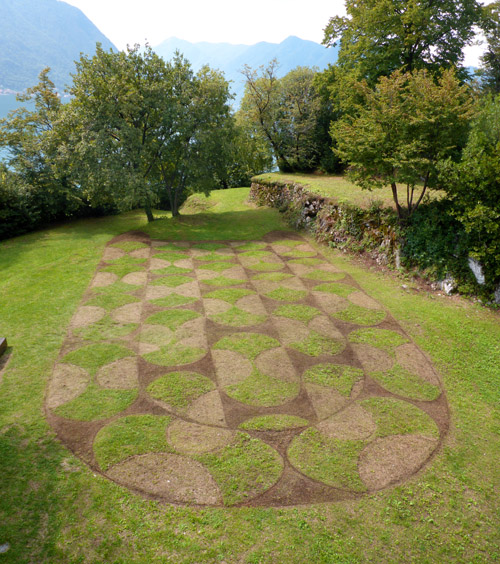
Le chiese in realtà sono sinonimo di sicurezza – molto più che di navi: L’asilo ecclesiastico è sempre stato di grande valore, e le chiese sono state in gran parte conservate durante le guerre. Sull’Isola Comacina, invece, le chiese sono state tutte distrutte e completamente rimosse. I sotterranei degli edifici e i pochi resti di pitture murali, ceramiche e mosaici pavimentali sono le uniche cose che si possono ancora trovare oltre alle narrazioni e alle leggende.
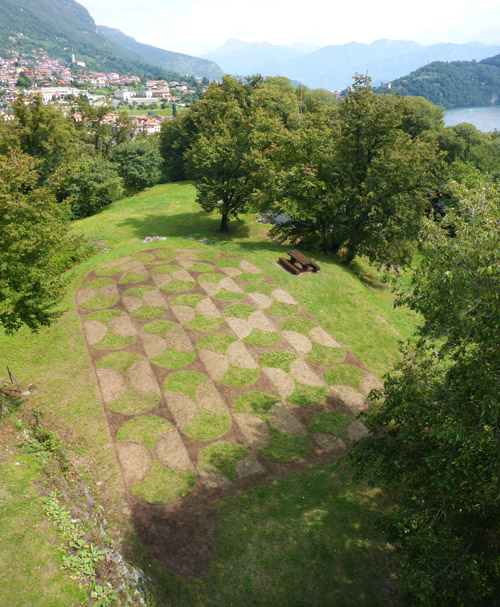
La leggenda narra anche che i sopravvissuti all’inferno delle „Castéls“ fuggirono in un luogo chiamato secondo la leggenda LA INSULA NOVA (la nuova isola), sull’altra sponda del lago di Como, vicino a Varenna. Poiché non ci sono indicazioni che ci sia stata una seconda isola sul lago di Como, si può supporre che si tratti di un nome simbolico.
Forse questa storia ci dice qualcosa del presente. Anche se LA INSULA NOVA è lontana dal Mar Mediterraneo e si riferisce ad una storia che ha quasi 1000 anni, l’opera d’arte ci ricorda anche che la gente oggi – forse più che mai – è in fuga e alla ricerca di un’isola sicura.
Tradotto con www.DeepL.com/Translator
Molte grazie: Fondazione Isola Comacina, Museo Antiquarium, Accademia di Belle Arti di Brera e STIHL.
HaraldNeumann.jpg)

